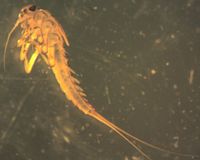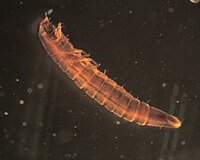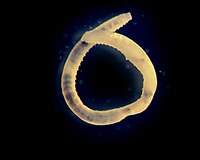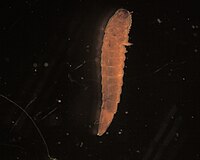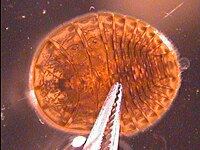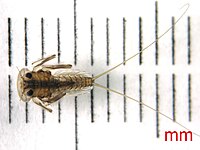Vermont EPSCoR's Streams Project; A Teacher Collaboration on WikiEducator
Openly shared content, practices, and developing resources from Vermont EPSCoR's Streams Project. Join this collaboration and make a difference!
 Mill Brook |
|---|
|
| Basin: | Lamoille River |
| State or Province: | Vermont |
| Country: | USA |
| Latitude: | 44.450612 |
| Longitude: | -72.938784 |
The following are the most common invertebrates collected from this stream site.
Baetis
- Order
- Ephemeroptera
- Family
- Baetidae
- Genus
- Baetis
- Common name
- The Little Olive
- Tied fly
- Sawyer Pheasant Tail Nymph
This mayfly has three "tails" and a unique head shape. Its gills are oval shaped and insert dorsally. More mature nymphs have long, dark wing pads.
Image of the long, dark wing pads.
Stenelmis
- Order
- Coleoptera
- Family
- Elmidae
- Genus
- Stenelmis
The larvae of
Stenelmis, as in
Ordobrevia, have a sternum on the ventral side of the pronotum. The main difference between the two genera is in the antennae the second segment is less than twice as long as the first in
Stenelmis.
The adult Stenelmis has a clear separation between the thorax and abdomen as well as a more distinctly separate head as compared to other genera.
Click here to see pictures of the sternum and
antennae-
Chironomidae
- Order
- Diptera
- Family
- Chironomidae
- Common name
- Nonbiting midge
- Tied fly
- Griffith's Gnat
Midge larvae tend to be the most common macroinvertebrate at our sites. As with other Diptera, there are no true jointed legs. Chironomidae do have a pair of prolegs at each end and preserved individuals tend to curl into a 'C'. Identification past family requires slide-mounted heads. We have seen philopotamid caddisflies misidentified with the chironomids and we suspect that that happens when samples are being sorted from trays. Under a microscope, six prominent legs can be seen on members of the caddisfly family Philopotamidae.
More information on Philopotamidae.
Oligochaeta
- Common name
- aquatic earthworms; black worms
Aquatic earthworms lack legs and are characterized by having 20 or more segments. Unlike leeches, they lack a suction disk. We collect members of two or more orders in this class as small numbers of stream sites and they are rarely numerous. They are more common at pond and lake sites.
Image of the 20 or more segments.
Optioservus
- Order
- Coleoptera
- Family
- Elmidae
- Genus
- Optioservus
The larvae of
Optioservus have open coxae, as determined by the straight definition between segments on the ventral side of the pronotum.
The adult Optioservus have a compact appearance, especially the head and thorax. There are also dorsal ridges and a characteristic diamond-shaped sutellum observable in the dorsal view.
Images of the straight definition between segments, the dorsal ridgesand the diamond-shaped scutellum.
Psephenus
- Order
- Coleoptera
- Family
- Psephenidae
- Genus
- Psephenus
The true "water penny" is commonly found in the waters sampled.
Psephenus has a rounded shape with relatively smooth edge. The
false water penny, whose edges are serrated, has a more oval appearance. The
gills on the ventral surface are found only in the true water pennies.
Another genus encountered in this family is Ectopria.
Hydropsyche
- Order
- Trichoptera
- Family
- Hydropsychidae
- Genus
- Hydropsyche
- Common name
- spotted caddis
- Tied fly
- dark cahill
Hydropsyche are net-spinning caddisflies and share most characteristics with other members of the Hydropsychidae, including the
Ceratopsyche.
Hydropsyche are distinguished from
Ceratopsyche by the presence of scale hairs and minute spines on the three most posterior abdominal segments.
More information on the Ceratopsyche can be found here.
Image of the sclerites in the intersegmental folds.
Heptageniidae
- Order
- Ephemeroptera
- Family
- Heptageniidae
- Common name
- flatheaded mayfly
- Tied fly
- Light Cahill, Wingless Pale Evening Dun
This family of mayflies can be characterized by their distinctly flattened heads and striking resemblance of the character 'Jack Skellington' from the movie 'The Nightmare Before Christmas.' This family can either have two or three cerci (tails).
Commonly encountered genera include:
Epeorus
Heptagenia
Maccaffertium
Rhithrogena

